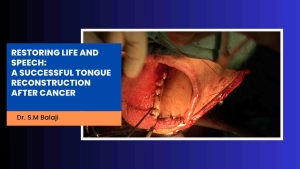Patient with facial deformity since a very young age
The patient is a 12-year-old female from Guntur in Andhra Pradesh, India. She was around two years old when she tripped on a step and landed quite heavily on her chin. Her parents immediately rushed her to a local doctor who had prescribed analgesics for the pain.
The pain subsided a few days later and the patient returned to her normal playful self. Her parents however did not seek any further medical attention for this.
It was soon evident that her lower jaw growth was not keeping pace with the rest of her face. Her facial esthetics began to decline gradually. By the time she was around 8-10 years of age, there was an obvious retrusion of the mandible.
Beginning of breathing difficulties caused by lower jaw deformity
It was around this time that her breathing difficulties began. She would gasp for air in the middle of the night in her sleep. Her sleep was interrupted by episodes of sudden awakening. She would complain of feeling extremely tired despite a full night’s sleep.
Her lower jaw retrusion had become esthetically compromising by this point and she had “bird facies.”
This was making the patient extremely frustrated and was affecting every aspect of her life. It was at this point that her parents decided to seek medical intervention for her condition. They met with an oral and maxillofacial surgeon at a local hospital who examined the patient.
Diagnosis of bilateral TMJ ankylosis from the childhood injury
He had obtained imaging studies for the patient, which revealed bilateral TMJ ankylosis. Oral and maxillofacial surgery planning was performed. The patient had subsequently undergone bilateral TMJ ankylosis release surgery, which had enabled increased mouth opening. The patient however continued to suffer from the breathing difficulties and daytime somnolence.
They had been counseled that she would need mandibular distraction surgery for resolution of her breathing difficulties. It was explained to them that this was a specialized surgery performed by only a few select surgeons in India. He had then referred them to our hospital.
Our hospital is a premier center for internal distraction osteogenesis in India. Facial asymmetry correction is enabled through this advanced surgical technique. Lower jaw asymmetry correction has helped scores of patients to lead completely normal lives.
Parents bring the patient to Balaji Dental and Craniofacial Hospital for consultation
Dr. SM Balaji, distraction osteogenesis specialist, obtained a detailed history. He also ordered imaging studies including a 3D CT scan. The patient had a bird face appearance. A review of the CT scan revealed that the patient had an extremely micrognathic mandible along with the absence of condyle and coronoid.
He also ordered sleep studies for the patient because of the history of nighttime awakening along with excessive tiredness. This confirmed the diagnosis of obstructive sleep apnea with very low oxygen saturation rates.
Dr. SM Balaji explained to the patient and her parents that obstructive sleep apnea was caused by the micrognathic mandible. This was causing the tongue to fall back into the throat thus obstructing her breathing during sleep.
He explained that the patient needed distraction osteogenesis with forwarding advancement of the mandible. This would result in increased airway space for the patient, thus correcting her sleep apnea.
He also explained that the patient would need mandibular condylar reconstruction with bone grafts at a later date. The parents were in agreement with the treatment plan and consented to surgery. Mandibular condyle reconstruction is performed with the use of autologous bone grafts.
Successful mandibular advancement through internal distraction osteogenesis
The patient underwent placement of bilateral internal mandibular distractors. Following a latency period of five days, a total mandibular distraction of 10 mm was performed. This resulted in a gain of sufficient length of the mandible.
It was explained to them that the distraction device will be left in place for four months. This would be the consolidation phase to allow for new bone formation at the distracting site.
There was an immediate improvement in the patient’s breathing following the completion of the distraction. She was able to sleep the whole night without any episodes of awakening. The patient also related that she felt refreshed and did not experience any daytime tiredness.
Patient returns after four months for removal of distractors
The patient and her parents returned to our hospital after four months for distractor removal surgery. This would be the completion of the distraction process. The transformation in the facial esthetics of the patient was very pleasing to the eye. The interincisal opening had become uniform without any tilt.
They related how the quality of her life had improved significantly following surgery. The esthetics of her face was also greatly improved. She was now able to be more active and involved with all the activities of daily living.
Surgical removal of bilateral internal mandibular distractors
The patient was taken to the Operating Theater and general anesthesia was induced following bronchoscopic intubation. Sulcular incisions were placed and the distractors were removed without incident. The incisions were then closed with sutures.
Her parents were counseled on the need for further coronoid and condyle reconstructive surgery. They expressed their understanding of the instructions and thanked the surgical team before their final discharge from the hospital.





